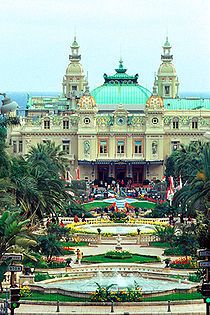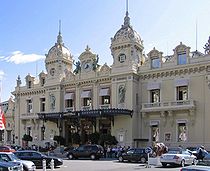- Monte Carlo Casino
-
This article is about the casino in Monaco. For the casino in Las Vegas, see Monte Carlo Resort and Casino.
The Monte Carlo Casino is a gambling and entertainment complex located in Monte Carlo, Monaco. It includes a casino, the Grand Théâtre de Monte Carlo, and the office of Les Ballets de Monte Carlo.
The Monte Carlo Casino is owned and operated by the Société des bains de mer de Monaco, a public company in which the Monaco government and the ruling family have a majority interest. The company also owns the principal hotels, sports clubs, foodservice establishments, and nightclubs throughout Monaco.
Contents
History
The idea of opening a gambling casino in Monaco belongs to Princess Caroline,[1] a shrewd, business-minded spouse of Prince Florestan I. Revenues from the proposed venture were supposed to save the House of Grimaldi from bankruptcy. The ruling family's persistent financial problems became especially acute after the loss of tax revenue from two breakaway towns, Menton and Roquebrune, which declared independence from Monaco in 1848 and refused to pay taxes on olive oil and fruit imposed by the Grimaldis.
In 1854 Charles, Florestan's son and future Prince of Monaco, recruited a team of Frenchmen—writer Albert Aubert and businessman Napoleon Langlois—to devise a development plan and write a prospectus to attract 4 million francs needed to build a spa for the treatment of various diseases, a gambling casino modeled from the Bad Homburg casino, and English-styled villas. Granted the concession of 30 years to operate a bathing establishment and gaming tables, Aubert and Langlois opened the first casino in 1856 in Villa Bellevu. Intended to be only a temporary location, the building was a modest mansion in La Condamine. In the following years the casino was moved several times until it finally ended up in the area called Les Spelugues (English: The Caves).
In the 1850s Monaco was an unlikely place for a resort to succeed. The lack of roads needed to connect Monaco to Nice and the rest of Europe, the absence of comfortable accommodations for visitors, as well as the concessionaires' failure to publicize the new resort, resulted in far fewer customers than was originally anticipated. Unable to raise the capital needed to operate the money-losing enterprise, Aubert and Langlois ceded their rights to Frossard de Lilbonne, who in turn passed it to Pierre Auguste Daval in 1857. Although the casino began to make a profit in 1859, Daval was not up to the task. Just like his predecessors, he was incompetent and lacked the ability to bring the gambling enterprise to the scale envisioned by Princess Caroline.[2] Frustrated, she dispatched her private secretary M.Eyneaud to Germany, hoping to recruit François Blanc, a French entrepreneur and operator of the Bad Homburg casino. Blanc declined the offer. It took a lot of time and persuasion on the part of Princess Caroline to convince the Blancs to move to Monaco. Princess Caroline even appealed to Madame Blanc, who she befriended during her first visit to Bad Homburg, with a suggestion that the Monaco's mild climate would be good for Madame Blanc's ill health.
Finally, in 1863 François Blanc agreed to take over the Monaco's casino business. To manage the new venture, a company—the Societe des Bains de Mer et du Cercle des Etrangers—was formed with capital of 15 million francs. Among the prominent investors were Charles-Bonaventure-François Theuret, Bishop of Monaco, and Cardinal Pecci, the future Pope Leo XIII. Blanc became the single majority stockholder in the company and received a 50-year concession, which would last until 1913. Blanc used his connections to quickly raise the required capital, and began the massive construction. The new casino building, the construction of which started in 1858, was completed in 1863. On Blanc's insistence, Les Spelugues area where the gambling complex was located was renamed to make it sound more attractive to casino visitors. A few suggestions were considered, and the name Monte Carlo was chosen in Prince Charles' honor.
In 1910 the casino building was expanded with a theatre, Salle Garnier, suitable for housing opera and ballet performances.
Until recently the Monte Carlo Casino has been the primary source of income for the House of Grimaldi and the Monaco economy.
Casino facilities
The casino has facilities to play a variety of games which include:
- Different kinds of roulette
- Stud poker
- Blackjack
- Trente et Quarante
- Craps
- Baccarat
- Video poker
- Slot machines
Breaking the bank
- In 1873, Joseph Jagger gained the casino great publicity by "breaking the bank at Monte Carlo" by discovering and capitalizing on a bias in one of the casino's roulette wheels. Technically, the bank in this sense was the money kept on the table by the croupier. According to an article in The Times in the late 19th century, it was thus possible to "break the bank" several times. The 1892 song The Man that Broke the Bank at Monte Carlo, made famous by Charles Coburns, was probably inspired by the exploits of Charles Wells, who "broke the bank" on many occasions on the first two of his three trips.
- According to the book Busting Vegas by Ben Mezrich, a team of blackjack players recruited from the Massachusetts Institute of Technology by team-leader Victor Cassius attempted to break the bank at Monte Carlo with the assistance of a team-play-based system. The book describes how the management of Monte Carlo responded to the progress of the team, whose members included Semyon Dukach and others mentioned by aliases.
Architecture
The casino was designed by the architect Charles Garnier, who also created the Paris opéra. It has a distinctly Beaux Arts style.
Interesting facts
- The citizens of Monaco are forbidden to enter the gaming rooms of the casino.[3] Identity documents are checked at the door to enforce this rule.
- Up until season 7 (2010/2011) the casino hosted the annual European Poker Tour Grand Final.
- The Monte Carlo methods, a class of random sampling algorithms, were named for the casino.
- The route of the Monaco Grand Prix (the Circuit de Monaco) is past the casino.
- Aristotle Onassis had a controlling stake in the Monte Carlo Casino in the 1950s until he was forced out by Rainier III, Prince of Monaco.
The casino in books and movies
- James Bond, a fictional British spy, is often associated with the Monte Carlo Casino.
- The architecture of glamorous Belle Époque building of the Monte Carlo Casino was used by Ian Fleming to describe a casino in 'Royale-Les-Eaux', a fictional resort featured in Fleming's first Bond novel, Casino Royale (1953).
- Monte Carlo and its casino were the locations for a number of James Bond movies, including Never Say Never Again and GoldenEye, as well as for the Casino Royale episode of the CBS' Climax! television show.
External links
Coordinates: 43°44′22″N 7°25′44″E / 43.73944°N 7.42889°E
Notes
- ^ Edwards, Anne (1992). The Grimaldis of Monaco: The Centuries of Scandal - The Years of Grace. William Morrow. ISBN 978-0688088378..
- ^ Sharma, K.K. (1999). Tourism and Culture. New Delhi: Sarup & Sons. ISBN 81-7625-056-2.
- ^ The rule banning all Monegasques from gambling or working at the casino was Princess Caroline's initiative, who used her position of the regent de facto of Monaco to dictate the conditions of gambling operations on the basis of her personal religious and moral beliefs. The idea that the casino was intended only for the foreigners was even emphasized in the name of the company that was formed to operate the gambling business, Societe des Bains de Mer et du Cercle des Etrangers (English: Company of Sea Bathing and of the Circles from Abroad). Source: Edwards, Anne (1992). The Grimaldis of Monaco: The Centuries of Scandal - The Years of Grace. William Morrow. ISBN 978-0688088378..
Categories:- Casinos in Monaco
Wikimedia Foundation. 2010.



